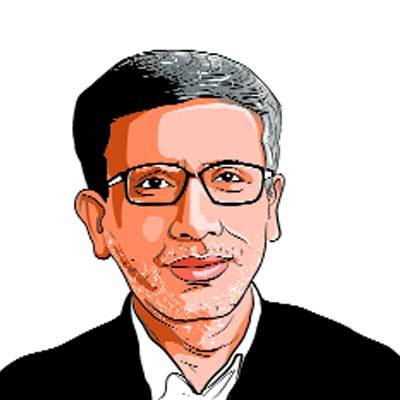Opinion Not just an eight-year itch
The break-up of the NDA in Bihar has happened now,but Nitish Kumars coalition of extremes may have been an embattled idea at ground level even earlier.
The break-up of the NDA in Bihar has happened now,but Nitish Kumars coalition of extremes may have been an embattled idea at ground level even earlier.
Nitish Kumar has completed eight years of his eventful tenure as Bihar chief minister this month. Till recently,he was leading a powerful coalition of the JD(U) and BJP,under the rubric of the NDA. The grand political coalition of extremes,assiduously built over the years,has been shattered. However,one has to examine to what extent the erstwhile coalition has also broken at the ground level. Can it bring back memories of the societal and class conflagrations of yesteryears?
The broad social tranquillity and peace in recent years,barring minor and engineered incidents of unrest,has ensured the leapfrogging of social and economic growth in Bihar. After the breaking of the NDA,a crescendo of opinion has risen from the vocal sections of the upper crust in the coalition of extremes about the non-performance of the Nitish government forgetting that till recently they were part of the coalition.
The coalition apparently broke when Narendra Modi was elevated as chairman of the BJPs campaign committee. But the social coalition at the ground level was under strain even earlier. The class and caste neutral economic policies of Nitish Kumar had a broad sub-national support,triggering the formation of a Bihari identity for the first time. Broad swathes of the upper echelons of society,who had abandoned the state earlier,were happily reconnected,with a full sense of ownership. This social coalition of extremes,both at the ground level and the administrative state apparatus,ensured a non-acrimonious growth. However,the strain in the coalition started surfacing on the question of positive discrimination for women,lower backwards and the Dalits in the Panchayati Raj Institutions (PRI),almost immediately after Nitish was elevated to the helm. Even Musahars,the most destitute among the Mahadalits,were brought to the centrestage with a number of dedicated social schemes for them,along with the fiat that they would hoist the national flag on Independence and Republic Days in the panchayats.
The implications of this inclusive social agenda of Nitish Kumar were initially ignored by the elite because of the spectre of Lalu Prasad. Over and above,they were confident that the rural power structure would not essentially alter because they would promote candidates for PRI institutions from their handpicked supplicants. Initially,they did succeed,but later,the subaltern lawmakers tried to assert themselves on their own. Thus,even after the jettisoning of the D. Bandopadhyaya Report on land reform in the first term,Nitish did succeed in breaking the rural political power structure,which Lalu could not do during his long rule.
But,unlike in Bengal,the Bihari elites could not de-link themselves from either land or the concurrent tryst with the rural power structures. The stock of an elite,howsoever entrenched in urban life,is still determined by his land endowment at his village home. So even slight alterations in the power structure meet resounding disapproval from both the village and urban elites. Thus,from the very onset of Nitishs second term and long before the final divorce with the BJP,a whisper campaign against Nitish was initiated,gradually becoming a smear campaign. The sudden love being expressed for Narendra Modi by a section of this coalition of extremes is intended to destabilise Nitish Kumars agenda of democratisation. Not only the rural elite,even the radical Left organisations suffered,as large numbers of their cadres opted for mainstream politics through the PRIs.
Even before Nitish came to power,social churning and subterranean ferment was witnessed all over the state. It had started as early as in the 1930s,but had gained considerable momentum since the 1970s. While other states took up the development agenda,albeit with varying seriousness,the elites in Bihar failed in the task. Secondly,the social agenda that autonomously surfaced in Bihar had also been ignored by the traditional elite.
In the process,elites in Bihar failed to chart out an independent incentive structure for economic growth and also failed to ensure the political stability in the state by not sharing power with the subaltern. The new political dispensation that took over the reigns of the state in the early 1990s was co-scripted initially by a group of young political leaders who were the products of the ideology-neutral JP Movement. However,after coming to power,the new ruling social dispensation committed the opposite mistake of excluding the traditional elite from the state-building exercise.
Thus,the new regime had two negative characteristics first,it did not have a development agenda and,second,its social base was narrow and exclusionary. Consequently,acrimony and retribution was the order of the day,causing tremendous suffering to Bihar,both economically and socially. In fact,it was the question of broadening the social base of the ruling coalition that prompted Nitish later to distance himself from the earlier ruling party.
The present JD(U) government essentially represents the agglomeration of non-powerful social categories. It is to be seen whether this counter-coalition against the coalition of extremes will survive or capitulate before the powerful backlash by upper social groups. Of course,the role of the state machinery will also be an important mediating factor in the emerging social dynamic.
The writer is member-secretary,Asian Development Research Institute (ADRI),Patna.


